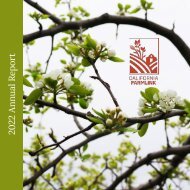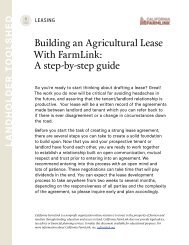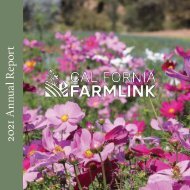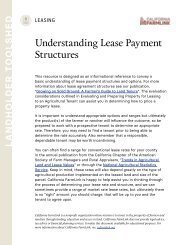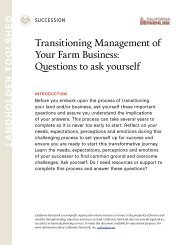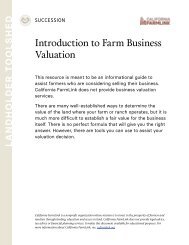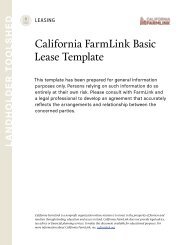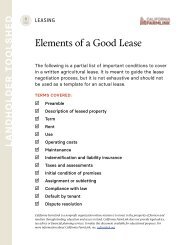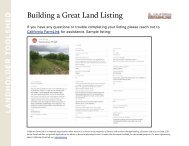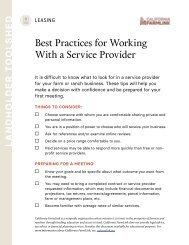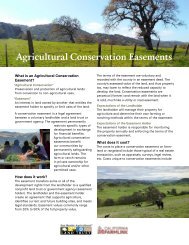Guide to Regenerative Grazing Leases: Opportunities for Resilience
California FarmLink and TomKat Ranch Educational Foundation teamed up to create this resource focused on land leases that support regenerative grazing practices. This guidebook aims to empower private, nonprofit, and public landholders, as well as easement-holders and grazing tenants.
California FarmLink and TomKat Ranch Educational Foundation teamed up to create this resource focused on land leases that support regenerative grazing practices. This guidebook aims to empower private, nonprofit, and public landholders, as well as easement-holders and grazing tenants.
You also want an ePaper? Increase the reach of your titles
YUMPU automatically turns print PDFs into web optimized ePapers that Google loves.
CHAPTER 2. <strong>Grazing</strong> <strong>Leases</strong> (Continued)<br />
These enhanced details may be placed in an AMP and referenced in the lease body.<br />
The goal is <strong>to</strong> make a transition and determination of drought conditions as clear as<br />
possible <strong>to</strong> avoid conflict and allow <strong>for</strong> a quick adaptation in management.<br />
Quality. For properties with riparian zones (rivers and streams), landholders and<br />
lessees should discuss target stream conditions and incorporate language that<br />
clarifies acceptable grazing practices. Target conditions may relate <strong>to</strong> bank stability,<br />
riparian health, and/or water quality. Clauses may require the lessee <strong>to</strong>:<br />
• fence lives<strong>to</strong>ck out of sensitive areas, maintain a specified setback, or graze<br />
only in certain periods (Note: Permanent exclusion of lives<strong>to</strong>ck from riparian<br />
zones can have unintended consequences; be<strong>for</strong>e requiring permanent<br />
exclusion, consider whether carefully managed lives<strong>to</strong>ck access might be an<br />
appropriate <strong>to</strong>ol <strong>to</strong> achieve target stream conditions.);<br />
• maintain a minimum cover (e.g. 70%) on road banks and slopes at risk of<br />
erosion;<br />
• create/maintain filter strips or other vegetative buffer; and/or<br />
• moni<strong>to</strong>r and respond <strong>to</strong> sediment and/or nutrient levels in streams.<br />
To address nutrient contamination from manure (as in the case of on-site composting),<br />
the agreement may state that the lessee should optimize distribution of manure <strong>for</strong><br />
nutrient cycling, soil health, and water quality. The lessee should make reasonable<br />
ef<strong>for</strong>ts <strong>to</strong> keep drift, flies, and other pests at a minimum and shall be responsible <strong>for</strong><br />
following all local and state regulations with regards <strong>to</strong> manure handling and runoff.<br />
The landholder is liable <strong>for</strong> compliance with Water Quality Control Board regulations,<br />
so any lease should require that the lessee comply as well.<br />
MONITORING AND EVALUATION<br />
Moni<strong>to</strong>ring is the act of measuring baselines and subsequent outcomes as<br />
practices are deployed in order <strong>to</strong> determine the effectiveness of those practices in<br />
achieving stated goals. A consistent moni<strong>to</strong>ring pro<strong>to</strong>col is critical <strong>to</strong> understanding<br />
which practices are achieving stated goals and which are not. Like SMART goals<br />
themselves, moni<strong>to</strong>ring and evaluation pro<strong>to</strong>cols are best located in an AMP (see<br />
Chapter 3 <strong>for</strong> details), where they directly reference the goals and can be adapted<br />
holistically.<br />
A lease or AMP that sets measurable goals must be very clear about how success<br />
is measured, how it may vary according <strong>to</strong> site and conditions, how the in<strong>for</strong>mation<br />
obtained from moni<strong>to</strong>ring shall be evaluated by both the landholder and the lessee,<br />
and any consequences <strong>for</strong> failure <strong>to</strong> meet stated goals.<br />
© Copyright 2022 Cali<strong>for</strong>nia FarmLink and TomKat Ranch Educational Foundation<br />
26



